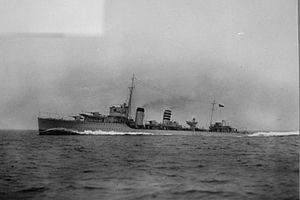HMS Codrington (D65)

HMS Codrington
|
|
| History | |
|---|---|
|
|
|
| Name: | HMS Codrington |
| Namesake: | Admiral Sir Edward Codrington |
| Ordered: | 6 March 1928 |
| Builder: | Swan Hunter, Tyne and Wear |
| Laid down: | 20 June 1928 |
| Launched: | 8 August 1929 |
| Commissioned: | 4 June 1930 |
| Motto: |
|
| Fate: | Bombed and sunk, 27 July 1940 |
| Badge: | On a Field Silver, a Lion passant Red |
| General characteristics (as built) | |
| Class and type: | A-class destroyer flotilla leader |
| Displacement: | |
| Length: | 343 ft (105 m) |
| Beam: | 33 ft 9 in (10.29 m) |
| Draught: | 12 ft 3 in (3.73 m) |
| Installed power: |
|
| Propulsion: | 2 × shafts; 2 × geared steam turbines |
| Speed: | 35 kn (65 km/h; 40 mph) |
| Range: | 5,000 nmi (9,300 km; 5,800 mi) at 15 knots (28 km/h; 17 mph) |
| Complement: | 185 |
| Armament: |
|
HMS Codrington was one of nine A-class destroyer built for the Royal Navy during the 1920s. She was the flotilla leader for the class. During the Second World War she served in Home waters and off the Norwegian coast, before being bombed and sunk on 27 July 1940 whilst in dock at Dover.
HMS Codrington was ordered on 6 March 1928 from the yards of Swan Hunter & Wigham Richardson, Wallsend, under the 1927 Naval Estimates. She was laid down on 20 June 1928 and was launched a year later on 8 August 1929. She was commissioned on 4 June 1930. After carrying out acceptance trials throughout February 1930, she was assigned to operate with the Mediterranean and Home Fleets. She has so far been the only ship of the Royal Navy to be named HMS Codrington, after Admiral Sir Edward Codrington, commander of the allied fleet at the Battle of Navarino.
Codrington was a flotilla leader and therefore larger than the other A-class destroyers. Her bridge structure was larger to provide the additional accommodation required for the Flotilla Staff. She displaced 2,012 long tons (2,044 t) with an overall length of 323 ft (98 m), a beam of 34 ft (10 m) and a draught of 19 ft (5.8 m). She was fitted with turbine machinery giving a speed of 37.74 kn (43.43 mph; 69.89 km/h) on trials carried out in February 1930. Some smaller weapons were fitted for use against aircraft. The ship had two quadruple 21 in (530 mm) torpedo tube mountings and for attacks on submarines was fitted with four depth charge chutes and two throwers, and an additional 4.7 in (120 mm) gun fitted between the two funnels. She spent a period in the reserve at Devonport Naval Base, but was refitted in 1938, being recommissioned on completion of the refit in August 1939 in time to participate in the Second World War.
...
Wikipedia
